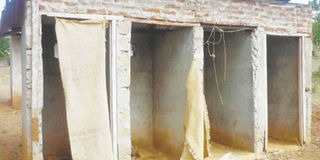Lack of toilets in Dar undermining health efforts

What you need to know:
On Thursday, the world commemorated the World Toilet Day coined around the theme “the link between sanitation and nutrition.” The day aims to draw awareness to the fact that many people do not have access to toilet – even though access to clean water and sanitation is a human right.
On Thursday, the world commemorated the World Toilet Day coined around the theme “the link between sanitation and nutrition.” The day aims to draw awareness to the fact that many people do not have access to toilet – even though access to clean water and sanitation is a human right.
According to the 2013 report titled “Economic Impacts of Poor Sanitation in Africa”, 5.4 million people on the continent have no latrine. Additionally, poor people are 41 times more likely to practise open defecation than the fairly affluent. In Tanzania, 25 million people use unsanitary or shared latrines.
A random survey by Sound Living in different areas of Dar es Salaam revealed that a majority of people within business areas do not have access to proper toilets - event though the respective areas accommodate hundreds of people. In some households, there are either no toilets at all, or only improper ones.
Instead, plastic bags or bottles serve the natural call. This is the case especially in areas where public toilets lack, but is also the first choice by people with limited income who cannot afford the Sh200 expected per call. This practice has its consequences. Most of the bags or bottles are disposed in the open, lessening the hygienic standard within the public sphere.
Asked about the toilet situation in the various areas people told Sound Living that sanitation is an issue. Addressing proper sanitation should be a priority starting on the family level, many people said. It is the way to create a society that values the importance of having proper toilets. It seems that a majority of parents are teaching their children sufficiently about the proper use of toilets and the importance of sanitation in general. Consequently, many grow up thinking that living without proper sanitation is normal. Some families do not have any form of toilet at all and do not care.
Yahya Rashid works at Ubungo bus terminal as a shopkeeper. According to him there are no more than three public toilets in the area, each charging Sh200 per visit. Not everyone, especially the small traders at the bus terminal, can afford that amount. “At the Ubungo bus terminal, it is normal to find bottles with urine inside in the open in the mornings. A majority of the tenants in the terminal can’t afford Sh200 per visit, as on average, during a day one would need to go at least four times,” says Rashid.
Furthermore, he says that during daytime some tenants and small traders at the terminal hide and pee at the walls. Mostly, the toilets are used by the passengers at the bus terminal.
The city council is responsible for collecting garbage at the terminal. The sweepers are the ones suffering with the collection of the garbage. Martha Charles, 35, is a hair dresser in a busy Mwenge market. She says that most of the frames were not built with toilets, thus people are forced to spend between Sh1000-1500 a day for toilet visits.
Additionally, she says not all of the business people can afford that amount of money, as everyone has different income levels. The situation forces some business people to urinate in hidden areas, thus increasing the risk of a cholera outbreak. In Kariakoo most of the toilets are not well equipped and dirty. Due to the big flow of people within this busy business area, they accommodate a very big number of visitors.
Florence Mugisha is a servant at the public toilet in Kariakoo. According to him, the problem is not only that the toilets are overloaded due to the big number of people using it, but also that most of the times there is no running water. “Running water is only available thrice a week. The remaining days I have to buy water to support my business. Generally the situation becomes challenging quickly, as most of the customers use a lot of water in the toilet. As a result I don’t make enough profit,” says Mugisha.
Due to the water scarcity Mugisha often only puts a little water in the toilet, pretending that water is finished in order to get the customers to use it economically. However, his strategy usually fails as a majority of his customers leave the toilets without flushing.
According to the report “Economic Impacts of Poor Sanitation in Africa” each person who practises open defecation spends almost 2.5 days a year looking for a secluded location to do his business. A waste of time that leads to large economic losses, averaging 14m US dollars (about 22.4m/-) each year.
According to the Geneva-based Water Supply & Sanitation Collaborative Council (WSSC), sanitation facilities are not considered to be of an acceptable standard when shared with other households, or open for public use.
The Latrine Construction Guide issued by the Health and Social Welfare ministry in 2009 says a latrine of acceptable standards should have an impervious floor, a wall height of at least 1.8 metres, as welll as a roof and a door.
It is estimated that 76 per cent of the country’s population still has no reliable access to sanitation facilities that hygienically separate human waste from the environment, including people’s dwellings. That translates to between 30 million and 33 million Tanzanians resorting to unhygienic sanitation facilities such as bucket latrines, public or shared toilets and open pit latrines.
The government admits that sanitation is inadequate and has outlined a number of strategies to reverse the trend by nearly 50 per ent by 2015. Nevertheless, independent hygiene experts say there are huge disparities in access within both the urban and rural population. Through the ten-year National Environmental Health, Hygiene and Sanitation Strategy 2008-2017, the Health and Social Welfare ministry has outlined options how to improve sanitation that include promotional, educational and participatory approaches. Others means are to review the National Sanitation and Hygiene Policy.
By late last year, the percentage of households in Tanzania with access to improved sanitation was around 24 per cent, with only 27 per cent of urban dwellers having access. By 2015, the government’s goal is to increase urban and rural accessibility to 45 per cent and 42 per cent respectively. A plan that the Geneva-based Water Supply & Sanitation Collaborative Council (WSSC) considers as very ambitious.
If the current accessibility trend does not improve, national sanitation coverage will stagnate at 24 per cent within the next four years, the council says – the same level it has been stuck at since 1990. Thus, Tanzanias chance of attaining the Millennium Development Goal (MDG) for sanitation of 62 per cent within 2015 is considered remote. Within rural dwellers and nomadic communities sanitation coverage is currently at only 12 per cent.
In 2005, the international NGO WaterAid estimated that addressing Tanzania’s sanitation needs would cost up to $520 million, which is about Sh780 billion in today’s exchange rates. WaterAid said in a report last year that many households in rural areas do not have decent toilets, which are too expensive to build for most rural dwellers.On Thursday, the world commemorated the World Toilet Day coined around the theme “the link between sanitation and nutrition.” The day aims to draw awareness to the fact that many people do not have access to toilet – even though access to clean water and sanitation is a human right.
According to the 2013 report titled “Economic Impacts of Poor Sanitation in Africa”, 5.4 million people on the continent have no latrine. Additionally, poor people are 41 times more likely to practise open defecation than the fairly affluent. In Tanzania, 25 million people use unsanitary or shared latrines.
A random survey by Sound Living in different areas of Dar es Salaam revealed that a majority of people within business areas do not have access to proper toilets - event though the respective areas accommodate hundreds of people. In some households, there are either no toilets at all, or only improper ones.
Instead, plastic bags or bottles serve the natural call. This is the case especially in areas where public toilets lack, but is also the first choice by people with limited income who cannot afford the Sh200 expected per call. This practice has its consequences. Most of the bags or bottles are disposed in the open, lessening the hygienic standard within the public sphere.
Asked about the toilet situation in the various areas people told Sound Living that sanitation is an issue. Addressing proper sanitation should be a priority starting on the family level, many people said. It is the way to create a society that values the importance of having proper toilets. It seems that a majority of parents are teaching their children sufficiently about the proper use of toilets and the importance of sanitation in general. Consequently, many grow up thinking that living without proper sanitation is normal. Some families do not have any form of toilet at all and do not care.
Yahya Rashid works at Ubungo bus terminal as a shopkeeper. According to him there are no more than three public toilets in the area, each charging Sh200 per visit. Not everyone, especially the small traders at the bus terminal, can afford that amount. “At the Ubungo bus terminal, it is normal to find bottles with urine inside in the open in the mornings. A majority of the tenants in the terminal can’t afford Sh200 per visit, as on average, during a day one would need to go at least four times,” says Rashid.
Furthermore, he says that during daytime some tenants and small traders at the terminal hide and pee at the walls. Mostly, the toilets are used by the passengers at the bus terminal.
The city council is responsible for collecting garbage at the terminal. The sweepers are the ones suffering with the collection of the garbage. Martha Charles, 35, is a hair dresser in a busy Mwenge market. She says that most of the frames were not built with toilets, thus people are forced to spend between Sh1000-1500 a day for toilet visits.
Additionally, she says not all of the business people can afford that amount of money, as everyone has different income levels. The situation forces some business people to urinate in hidden areas, thus increasing the risk of a cholera outbreak. In Kariakoo most of the toilets are not well equipped and dirty. Due to the big flow of people within this busy business area, they accommodate a very big number of visitors.
Florence Mugisha is a servant at the public toilet in Kariakoo. According to him, the problem is not only that the toilets are overloaded due to the big number of people using it, but also that most of the times there is no running water. “Running water is only available thrice a week. The remaining days I have to buy water to support my business. Generally the situation becomes challenging quickly, as most of the customers use a lot of water in the toilet. As a result I don’t make enough profit,” says Mugisha.
Due to the water scarcity Mugisha often only puts a little water in the toilet, pretending that water is finished in order to get the customers to use it economically. However, his strategy usually fails as a majority of his customers leave the toilets without flushing.
According to the report “Economic Impacts of Poor Sanitation in Africa” each person who practises open defecation spends almost 2.5 days a year looking for a secluded location to do his business. A waste of time that leads to large economic losses, averaging 14m US dollars (about 22.4m/-) each year.
According to the Geneva-based Water Supply & Sanitation Collaborative Council (WSSC), sanitation facilities are not considered to be of an acceptable standard when shared with other households, or open for public use.
The Latrine Construction Guide issued by the Health and Social Welfare ministry in 2009 says a latrine of acceptable standards should have an impervious floor, a wall height of at least 1.8 metres, as welll as a roof and a door.
It is estimated that 76 per cent of the country’s population still has no reliable access to sanitation facilities that hygienically separate human waste from the environment, including people’s dwellings. That translates to between 30 million and 33 million Tanzanians resorting to unhygienic sanitation facilities such as bucket latrines, public or shared toilets and open pit latrines.
The government admits that sanitation is inadequate and has outlined a number of strategies to reverse the trend by nearly 50 per ent by 2015. Nevertheless, independent hygiene experts say there are huge disparities in access within both the urban and rural population. Through the ten-year National Environmental Health, Hygiene and Sanitation Strategy 2008-2017, the Health and Social Welfare ministry has outlined options how to improve sanitation that include promotional, educational and participatory approaches. Others means are to review the National Sanitation and Hygiene Policy.
By late last year, the percentage of households in Tanzania with access to improved sanitation was around 24 per cent, with only 27 per cent of urban dwellers having access. By 2015, the government’s goal is to increase urban and rural accessibility to 45 per cent and 42 per cent respectively. A plan that the Geneva-based Water Supply & Sanitation Collaborative Council (WSSC) considers as very ambitious.
If the current accessibility trend does not improve, national sanitation coverage will stagnate at 24 per cent within the next four years, the council says – the same level it has been stuck at since 1990. Thus, Tanzanias chance of attaining the Millennium Development Goal (MDG) for sanitation of 62 per cent within 2015 is considered remote. Within rural dwellers and nomadic communities sanitation coverage is currently at only 12 per cent.
In 2005, the international NGO WaterAid estimated that addressing Tanzania’s sanitation needs would cost up to $520 million, which is about Sh780 billion in today’s exchange rates. WaterAid said in a report last year that many households in rural areas do not have decent toilets, which are too expensive to build for most rural dwellers.




